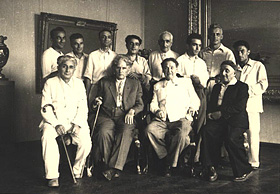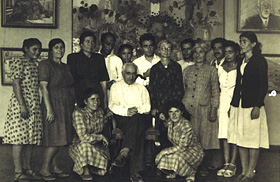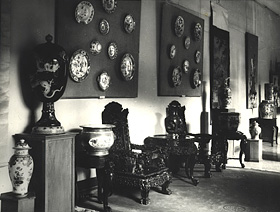The Museum / History
1935-1947 The State Fine Art Museum
 At the end of 1924, by the request of Al. Tamanian and M. Sarian, art historian Ruben Drambian moved from Leningrad to Yerevan. Quitting his work in the State Russian Museum, in 1925, Drambian shouldered the responsibilities of the Head of the Department of Fine Arts, and in 1935, when the substantially enriched and expanded department grew into an independent State Museum of Fine Arts, Drambian became its first director, serving in this post until 1951. His professional intuition, talent for accumulating collection items and museum work experience predetermined the future course of development of the gallery. Thanks to the well-planned and systematized distribution of collections (purchases from republican exhibitions, studios, private individuals, allocations from museum funds of Russia, the State Hermitage, the State Russian Museum, national collections) as well as continuous donations, the Museum of Fine Arts quickly won the fame of one of the best museums in the Soviet Union. At this stage research became an indispensable part of museum activity.Under the supervision of L. Durnovo, art historian and connoisseur of ancient art invited from Moscow (1882-1963), the museum initiated research and replication of medieval Armenian frescoes and miniatures.The team of young artists, including Y. Khachatrian, M. Chubarian, R. Loris-Melikov, V. Baghdasarian, G. Khanaghian, H. Gharagyozian, studied the specialized professions of reproduction and restoration. During expeditions in different regions of Armenia the team discovered, investigated, dated and reproduced the works of Armenian monumental painting.
At the end of 1924, by the request of Al. Tamanian and M. Sarian, art historian Ruben Drambian moved from Leningrad to Yerevan. Quitting his work in the State Russian Museum, in 1925, Drambian shouldered the responsibilities of the Head of the Department of Fine Arts, and in 1935, when the substantially enriched and expanded department grew into an independent State Museum of Fine Arts, Drambian became its first director, serving in this post until 1951. His professional intuition, talent for accumulating collection items and museum work experience predetermined the future course of development of the gallery. Thanks to the well-planned and systematized distribution of collections (purchases from republican exhibitions, studios, private individuals, allocations from museum funds of Russia, the State Hermitage, the State Russian Museum, national collections) as well as continuous donations, the Museum of Fine Arts quickly won the fame of one of the best museums in the Soviet Union. At this stage research became an indispensable part of museum activity.Under the supervision of L. Durnovo, art historian and connoisseur of ancient art invited from Moscow (1882-1963), the museum initiated research and replication of medieval Armenian frescoes and miniatures.The team of young artists, including Y. Khachatrian, M. Chubarian, R. Loris-Melikov, V. Baghdasarian, G. Khanaghian, H. Gharagyozian, studied the specialized professions of reproduction and restoration. During expeditions in different regions of Armenia the team discovered, investigated, dated and reproduced the works of Armenian monumental painting.
 Many of the frescoes that ornamented the ruined churches left to the mercy of fate no longer exist, and as a result their replications have acquired the value of original works. Owing to L. Durnovo and the team of Armenian young artists, the visitors of the National Gallery of Armenia can today admire the frescoes of Arutchavank, Lmbatavank, the Monastery of Tatev, and many other churches. It is noteworthy that later the collection was greatly enhanced by the additional new reproductionser. By 1985 made it was possible to exhibit these frescoes, as well as the replications of miniatures and high relief church sculptures in special rooms of the new gallery building. The medieval art exposition shows the chronological sequence of Armenian fine arts, from the early Middle Ages to 17-18th century church painting, followed by modern and contemporary art. From 1930-1950, the museum collection was regularly enriched, giving rise to temporary exhibitions, brief catalogues and booklets. Armenian, Russian and Western European art was presented in three sections of permanent exhibition. The work was administered by respective research departments.
Many of the frescoes that ornamented the ruined churches left to the mercy of fate no longer exist, and as a result their replications have acquired the value of original works. Owing to L. Durnovo and the team of Armenian young artists, the visitors of the National Gallery of Armenia can today admire the frescoes of Arutchavank, Lmbatavank, the Monastery of Tatev, and many other churches. It is noteworthy that later the collection was greatly enhanced by the additional new reproductionser. By 1985 made it was possible to exhibit these frescoes, as well as the replications of miniatures and high relief church sculptures in special rooms of the new gallery building. The medieval art exposition shows the chronological sequence of Armenian fine arts, from the early Middle Ages to 17-18th century church painting, followed by modern and contemporary art. From 1930-1950, the museum collection was regularly enriched, giving rise to temporary exhibitions, brief catalogues and booklets. Armenian, Russian and Western European art was presented in three sections of permanent exhibition. The work was administered by respective research departments.
 The above-mentioned period was remarkable for the museum as its collection was enriched by the donations of three prominent collectors. Romanian-Armenian art historian G. Zambakhchian consigned to the museum a number of valuable paintings by Th. Rousseau, Díaz de la Peña, A. Monticelli, E. Boudin, A. Bénard, and others, which imparted a new quality to the collection of French painting. The large collection of another Romanian-Armenian collector Vahan Barakian, donated to the museum, was comprised of paintings and graphic works by prominent Romanian painters, European engravings, as well as 150 pieces of decorative applied art (representing the art of Europe, Russia, and the East). In 1936 the renowned Armenian graphic artist Edgar Chahine, who enjoyed wide recognition in France, increased the number of his works in the museum by 170 engravings, which he sent from Paris for his private exhibition in Yerevan. Thirty paintings and nine drawings were added to the collection of world-known marine artist Hovh. Aivazovsky by his sincere admirer Abraham Zintchian (France). One of the major events in the life of the museum was associated with Aivazovsky’s name. At the time of the Great Patriotic War the museum continued working in full force. Moreover, ensuring the security of its collections, it even provided room for the precious collection and archive of the Aivazovsky Picture Gallery, evacuated from Theodosia. Since November 8, 1941, the collection was kept in the Museum of Fine Arts. On May 2, 1942 it was exhibited, jointly organized by the administration of the museum and the Artists’ Union of Armenia on the occasion of the Aivazovsky’s 125th anniversary. The exhibition was held in the Persian Mosque which then hosted the Artists’ Union then. The exhibition housed fifty-seven seascapes by Aivazovsky, as well as the works of ten different Western European painters. The opening ceremony attracted Martiros Sarian, Head of Cultural Affairs Department A. Shahinian, Academic J. Orbeli, the Director of the Museum R. Drambian and the Director of the Aivazovsky Picture Gallery of Theodosia N. Barsamov. In only twelve days an astounding number of 45000 people visited the exhibition. On November 5, 1944 the paintings were all returned to the Theodosia Picture Gallery in Crimea.
The above-mentioned period was remarkable for the museum as its collection was enriched by the donations of three prominent collectors. Romanian-Armenian art historian G. Zambakhchian consigned to the museum a number of valuable paintings by Th. Rousseau, Díaz de la Peña, A. Monticelli, E. Boudin, A. Bénard, and others, which imparted a new quality to the collection of French painting. The large collection of another Romanian-Armenian collector Vahan Barakian, donated to the museum, was comprised of paintings and graphic works by prominent Romanian painters, European engravings, as well as 150 pieces of decorative applied art (representing the art of Europe, Russia, and the East). In 1936 the renowned Armenian graphic artist Edgar Chahine, who enjoyed wide recognition in France, increased the number of his works in the museum by 170 engravings, which he sent from Paris for his private exhibition in Yerevan. Thirty paintings and nine drawings were added to the collection of world-known marine artist Hovh. Aivazovsky by his sincere admirer Abraham Zintchian (France). One of the major events in the life of the museum was associated with Aivazovsky’s name. At the time of the Great Patriotic War the museum continued working in full force. Moreover, ensuring the security of its collections, it even provided room for the precious collection and archive of the Aivazovsky Picture Gallery, evacuated from Theodosia. Since November 8, 1941, the collection was kept in the Museum of Fine Arts. On May 2, 1942 it was exhibited, jointly organized by the administration of the museum and the Artists’ Union of Armenia on the occasion of the Aivazovsky’s 125th anniversary. The exhibition was held in the Persian Mosque which then hosted the Artists’ Union then. The exhibition housed fifty-seven seascapes by Aivazovsky, as well as the works of ten different Western European painters. The opening ceremony attracted Martiros Sarian, Head of Cultural Affairs Department A. Shahinian, Academic J. Orbeli, the Director of the Museum R. Drambian and the Director of the Aivazovsky Picture Gallery of Theodosia N. Barsamov. In only twelve days an astounding number of 45000 people visited the exhibition. On November 5, 1944 the paintings were all returned to the Theodosia Picture Gallery in Crimea.
- 1921-1935 Art Department of the State Museum
- 1935-1947 The State Fine Art Museum
- 1947-1991 The State Gallery of Armenia
- 1991-2011 The National Gallery of Armenia